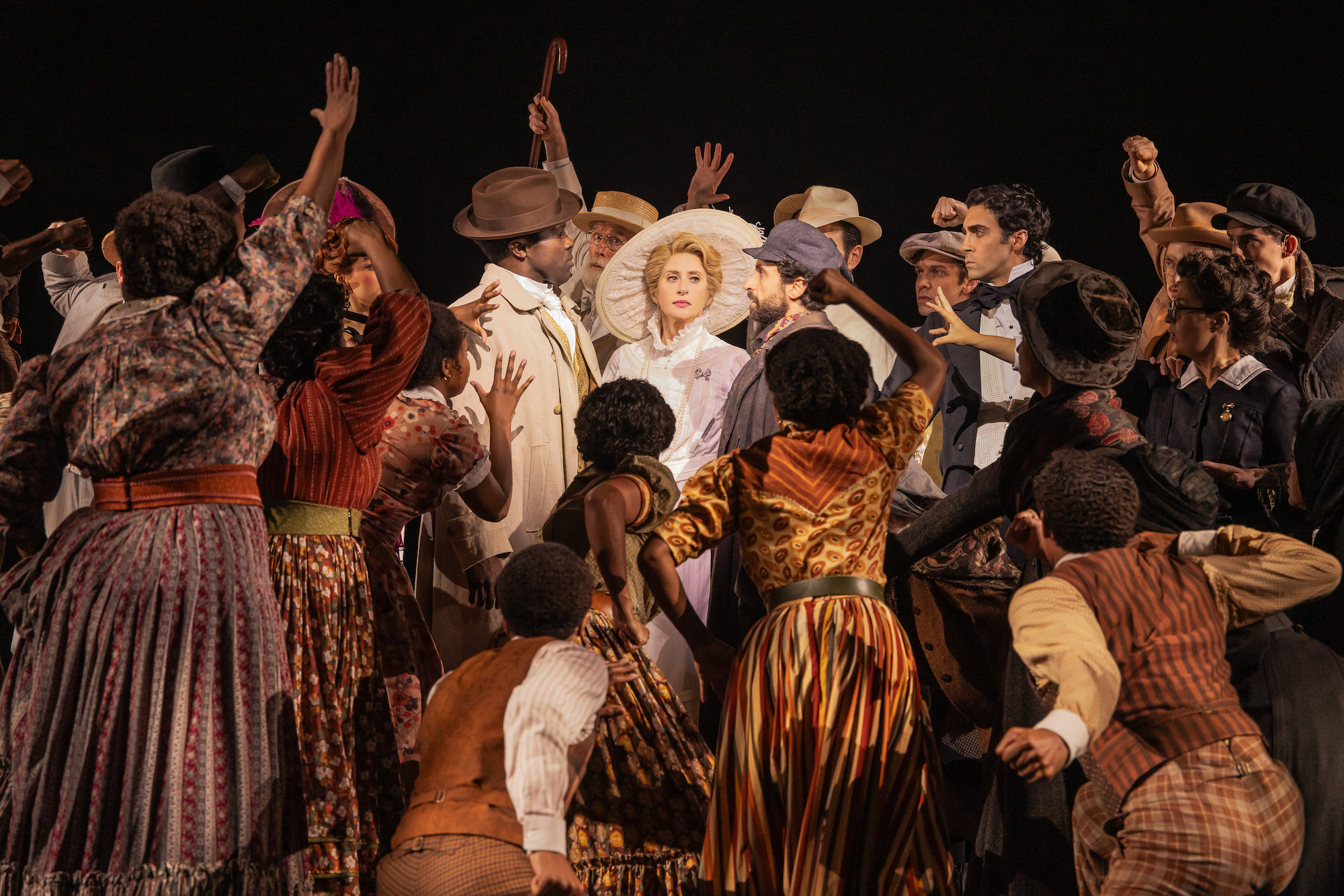Director Lear deBessonet has chosen wisely for the first production of her inaugural season as Artistic Director of Lincoln Center Theater by resurrecting the grand, albeit imperfect, musical *Ragtime*. Originally staged on Broadway in a bloated 1998 production, this revival offers a second chance to realize the show’s glory. As she demonstrated with the recent Encores! production, deBessonet delivers a thoroughly dazzling reclamation—at least in the first act.
The opening number is a glorious staging that establishes themes both musical and otherwise, setting a promising tone. However, *Ragtime*’s second act has always been problematic. One power ballad follows another, and Terrence McNally’s book struggles to streamline the sprawling masterwork that is E.L. Doctorow’s 1975 novel. Although deBessonet and her marvelous cast—led by a towering Joshua Henry—come tantalizingly close to making all the necessary fixes, *Ragtime* remains a flawed masterwork of its era.
With an often rapturous score by Stephen Flaherty and Lynn Ahrens, *Ragtime* contains big, rousing numbers that still grab and refuse to let go. None is more memorable than the beautiful opening number, which introduces us to the iconic *Ragtime* theme music that recurs throughout the show. This number also sets up McNally’s and Doctorow’s primary subject: America itself.
Staying true to Doctorow’s novel—though never quite achieving its mastery—*Ragtime* sets out to illustrate the grand notion of America as a melting pot. It depicts a time in the early 1900s when the country still offered the hope or ideal of justice and equality.
### A Story of Intermingling Lives
The prologue introduces the three main groups of characters who will comingle with varying outcomes throughout the musical: a well-to-do white family from New Rochelle; a Black community in Harlem; and Jewish immigrants newly arrived to the Lower East Side from the shtetls of Eastern Europe.
In *Ragtime*’s most impressive achievement, these three groups—and their distinct musical motifs and dance choreographies—are introduced in the astonishing opening number. They appear separately at first but then blend together, illustrating the melting pot that was—and is—New York City. Some of these connections will take root, and others won’t.
The intermingling plotlines follow:
– A white upper-middle-class family from New Rochelle: Father (Colin Donnell), Mother (Caissie Levy), Younger Brother (Ben Levi Ross), and little Edgar (Nick Barrington). Their lives change when Mother finds a half-buried infant abandoned in her garden by Sarah (Nichelle Lewis), the lover of Harlem ragtime pianist Coalhouse Walker (Joshua Henry).
– With Father away on a North Pole expedition (certainly a “first world problem”), a compassionate Mother takes in Sarah and her child, tying the fates of the New Rochelle family and the Harlem community together.
– Meanwhile, Jewish immigrant and artist Tateh (a very fine Brandon Uranowitz) and his young daughter (Tabitha Lawing) struggle to build a life in the tenements of New York City. Their dire circumstances leave both Tateh—and the audience—uncertain about the little girl’s survival.
As the story unfolds, Tateh’s path will eventually intersect with those of both the New Rochelle family and Coalhouse Walker’s Harlem community.
### History Meets Fiction
More so than Miloš Forman’s 1975 film adaptation, the musical honors Doctorow’s splendid conceit of placing real-life historical figures like anarchist Emma Goldman, illusionist Harry Houdini, and vaudeville star Evelyn Nesbit into the fictional world of *Ragtime*. This blending of fact and fiction is *Ragtime*’s secret weapon and a key reason why the show resonates so strongly.
Emma Goldman—in this production portrayed by Shaina Taub (known from *Suffs*)—is just one of many remarkable performances that give this *Ragtime* its power.
Flaherty and Ahrens have gifted musical theater with some of the most soaring numbers in modern memory. These include the unforgettable opening number (“*Ragtime*,” the show’s theme, which lingers long after the curtain falls), the gut-wrenching “Your Daddy’s Son” (singularly bone-chilling in Lewis’s performance), and “Wheels of a Dream,” a song that surely secures *Ragtime*’s place in the musical theater pantheon, beautifully performed here by Henry and Lewis.
### Simplifying a Rich Narrative
To summarize Doctorow’s novel as adapted by the musical:
– New Rochelle’s Mother discovers an abandoned baby.
– Musician Coalhouse Walker returns, seeking to reunite with his lover Sarah and their newborn son.
– Impoverished Tateh and his daughter cross paths with the wealthy Mother and young son Edgar, eventually uniting in a more significant way years later.
All this intermingling is foretold and underscored by the extraordinary opening number, which establishes specific musical and dance motifs linked to each group.
One of the great achievements of Flaherty and Ahrens’s score is how it melds the representational sounds of each group: operetta for the white New Rochelle residents, gospel and ragtime for Harlem, and klezmer for the Jewish immigrants. These distinct strains are heard both separately and as part of a complex, wonderful whole—the musical embodiment of America’s melting pot.
### Production Elements and Design
In keeping with its Encores! roots, this Broadway *Ragtime* unfolds on a mostly spare stage. David Korins’s scenic design makes excellent use of wheeled staircases to evoke various settings, such as the prows of ships for Father and Tateh’s departures or Emma Goldman’s stage at her historic Union Square rally.
Projections by 59 Studio provide impressionistic backdrops that shift with the scenes—from warm sunset colors to flag images, purples, and blues. Linda Cho’s costume design is flawless throughout, adding authenticity and texture to the production.
### Strengths and Stumbles in the Second Act
While the second act typically stumbles—both in song, where repetition and sameness creep in, and in storytelling—it still offers some truly terrific numbers including “The Night That Goldman Spoke At Union Square,” “Till We Reach That Day,” “Sarah Brown Eyes,” and “He Wanted To Say.”
Despite some less successful moments—most notably a jokey, padded “take-me-out-to-the-ballgame” baseball number—the Flaherty-Ahrens score remains *Ragtime*’s signature achievement.
### Standout Performances
Director Lear deBessonet could have provided a clearer focus or point of view for *Ragtime*’s telling of America’s immigrant tale—especially considering its resonance in today’s world. Nevertheless, she brings out the best in a uniformly splendid cast.
Joshua Henry (*Carousel*) proves once again there is no better singer working the Broadway stage. Nichelle Lewis, as the tragic Sarah, leaves a lasting impression, even if her contemporary singing style doesn’t perfectly meld with Henry’s more classical approach.
Caissie Levy is top-flight as Mother, Brandon Uranowitz nearly steals the show as Tateh, and Shaina Taub is exceptionally winning as Emma Goldman. Taub’s performance makes one wonder anew why the show’s authors didn’t include the plotline where Emma Goldman meets the showgirl Evelyn Nesbit (played here by Anna Grace Barlow)—a missed opportunity if ever there was one.
### Conclusion
Despite its faults and near misses, *Ragtime* remains, like its ’90s contemporaries *Titanic* and *Parade*, ripe for rediscovery. Lear deBessonet takes on the challenge and wins, rescuing a near-classic from the excesses of the 1990s.
Ultimately, *Ragtime*, imperfect as it may be, deserves a place among the most significant musical theater achievements of that decade. This revival proves, once and for all, that its story, music, and message still resonate powerfully on today’s Broadway stage.
https://deadline.com/2025/10/ragtime-broadway-review-1236583715/



